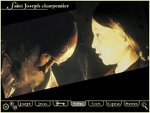The story of music at Cluny was told visually with compelling beauty in two sculptured capitals that survive from the apse of Hugh's great church. In the sanctuary, the architectural climax of the whole edifice, was a series of columns grouped in a semicircle around the high altar, and the capitals of these pillars constituted the apogee of late 11th-century sculptural skill. Here, capital by capital, were to be seen symbolic expressions of the highest ideals of the monk's life. One capital, for example, presented on its four faces the theological virtues; another, the cardinal virtues. On a third were pictured the cycles and labors of the monk's year in terms of the four seasons; and his hopes for the hereafter were portrayed by the four rivers and trees of Paradise. Finally, his praise for the Creator was expressed in a double quaternity with figures to symbolize the eight tones of sacred psalmody. This inclusion of music in the sacred precinct, next to the symbols of the highest human virtues and heavenly beauties, was further evidence of the high esteem in which the tonal art was held by the monks of Cluny.
Les 4 premiers tons
 Le premier ton est représenté par un jeune homme jouant du luth. Son personnage, comme tous ceux du septième chapiteau, sont entourés d'une mandorle, le long de laquelle court un texte, en latin le "titulus".
Le premier ton est représenté par un jeune homme jouant du luth. Son personnage, comme tous ceux du septième chapiteau, sont entourés d'une mandorle, le long de laquelle court un texte, en latin le "titulus".Ici , le texte dit : "Hic tonus orditur modulamina musica primus - Ce premier ton ordonne les harmonies musicales."
On the first of the eight faces of these twin capitals is inscribed: "This tone is the first in the order of musical intonations," and the figure is that of a solemn-faced youth playing on a lute. Here the symbolism of the stringed instrument stems from the belief in the power of music to banish evil, as David had cast out Saul's evil spirit when he played to him.
 Le deuxième ton est illustré par une femme qui danse, rythmant la musique à l'aide de petites cymbales, attachées ensemble par un cordon. Le texte dit : "Subsequor ptongus numero vel lege secundus - ensuite vient un son qui est le second en nombre ou selon la loi."
Le deuxième ton est illustré par une femme qui danse, rythmant la musique à l'aide de petites cymbales, attachées ensemble par un cordon. Le texte dit : "Subsequor ptongus numero vel lege secundus - ensuite vient un son qui est le second en nombre ou selon la loi." The second tone is represented by the figure of a young woman dancing and beating a small drum, the inscription reading, "There follows the tone which by number and law is second." Such percussion instruments are known to have been used to accompany medieval processions on joyful feast days in the manner described in the 68th Psalm: "The singers went before, the players on instruments followed after; among them were damsels playing with timbrels."
 Le troisième ton est figuré par un homme jouant du psaltérion ou de la cithare. On peut lire, sur le pourtour de la mandorle : "Tertius impigit Christumque resurgerre pingit - le troisième met en avant et peint la résurrection du Christ" Le troisième ton rappelle donc, le troisième jour après la crucifixion, le jour de la Résurrection.
Le troisième ton est figuré par un homme jouant du psaltérion ou de la cithare. On peut lire, sur le pourtour de la mandorle : "Tertius impigit Christumque resurgerre pingit - le troisième met en avant et peint la résurrection du Christ" Le troisième ton rappelle donc, le troisième jour après la crucifixion, le jour de la Résurrection.The next inscription says: "The third strikes, and represents the resurrection of Christ." The instrument here is of the lyre type with a sounding board added, which is one of the 11th- century forms of the psaltery, the legendary instrument with which David accompanied himself as he sang the psalms. This instrument with its gut strings stretched over the wooden frame roughly resembles a cross and was used as a symbolic reference to Christ stretched on the Cross for the redemption of the world.
 Le quatrième ton est représenté par un jeune homme portant un tintinnabulum particulier, puisque sonnant le glas funéraire. Le texte dit : "Succedit quartus simulans in carmine planctus" - Vient ensuite le quatrième, qui par ses chants, imite les lamentations". Evocation probable de l'histoire de Lazare, qui ressuscite le quatrième jour, après de nombreuses lamentations de ses amis et de sa famille (Jean 11 : 1- 26 et 12 : 1-11).
Le quatrième ton est représenté par un jeune homme portant un tintinnabulum particulier, puisque sonnant le glas funéraire. Le texte dit : "Succedit quartus simulans in carmine planctus" - Vient ensuite le quatrième, qui par ses chants, imite les lamentations". Evocation probable de l'histoire de Lazare, qui ressuscite le quatrième jour, après de nombreuses lamentations de ses amis et de sa famille (Jean 11 : 1- 26 et 12 : 1-11). The fourth figure is that of a young man playing a set of chime bells, and the accompanying inscription reads: "The fourth follows representing a lament in song." The Latin word planctus denotes a funeral dirge, and the practice of ringing bells at burials is pictured in the contemporary representation of the burial procession of Edward the Confessor from the Bayeux Tapestry where the figures accompanying the bier have small bells in their hands



1 commentaire:
Que sont devenus les quatre autres tons de Cluny ? on ne cite généralement que les 4 premiers.
Merci
Enregistrer un commentaire